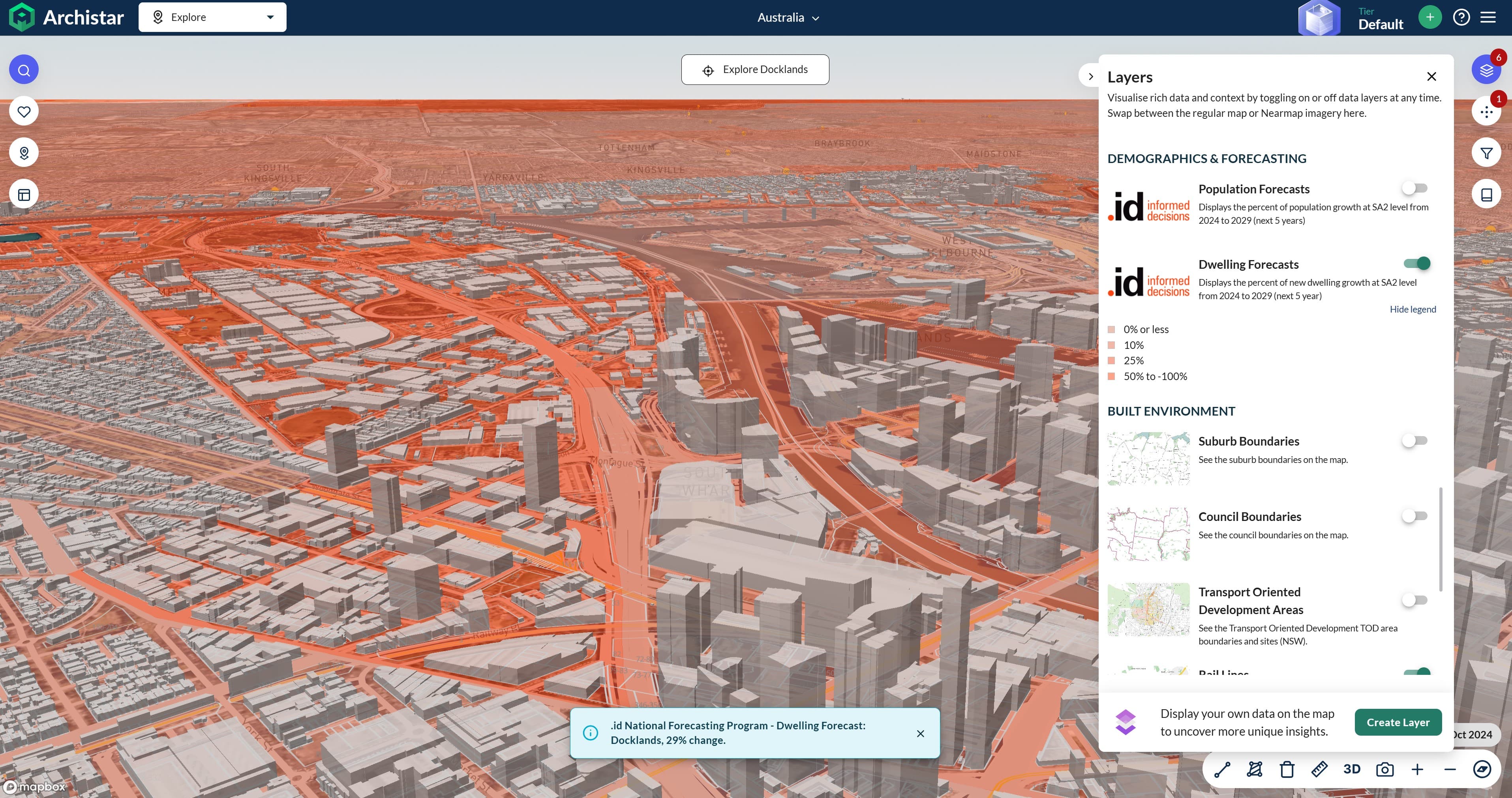BLOG
The ripple effect: How Tasmania's population growth will shape demand for essential services
The ripple effect: How Tasmania's population growth will shape demand for essential services
The demographic drivers behind Tasmania’s growth are changing. In our recent webinar, Fighting history: Can Tasmania sustain population growth after the pandemic?, we explained why we don’t expect Tasmania’s recent growth trajectory to be sustained over the next 25 years, and explored the key factors that will influence the state’s population growth.
In this article, we look at what this population forecast means for those planning utilities and essential services in Tasmania, the factors they should consider when planning for a slower growth future, and how our independent forecasts of population and housing can help these organisations plan and invest with confidence.
Tasmania has experienced a spike in population growth over recent years, largely driven by interstate migration. But this migration is now declining. The long-range forecast over the next two decades is for population growth to slow.

This doesn’t mean the population isn’t changing. In particular, the age structure will shift over the next twenty-five years, with a decline in the number of school-aged children and a growing population over 85.
This has implications for Tasmania’s utilities sector. Population growth drives demand for housing, and changing demographics can shift demand for essential services like:
- Water
- Electricity
- Internet
- Sewerage
- Waste management
And it’s not just the rate of growth and size of the population that matters. Where the future population will be dispersed geographically also impacts utility planning.
Understanding where – and when – there will be future demand for utilities revolves around understanding the relationship between population growth and settlement patterns. The supply of housing and where people choose to live drives their demand for services and utilities.
In this article we explore the key factors influencing Tasmania’s population growth over the next 25 years, and what the demand for essential services could mean for the utilities sector.
Tasmania’s Population Growth Forecast
Over the next 25 years, Tasmania’s population growth will decline to 0.13% by 2046. In real numbers, this would see the population increase from just under 568k in 2021 to 629k by 2046.

The reasons behind this declining population growth come back to the three major drivers of population change:
- Natural increase,
- Overseas migration, and
- Interstate migration
Natural increase was the major source of population growth across Australia for many decades. But it has also been steadily declining, largely influenced by our decreasing birth rate. And for Tasmania, the rate of natural population increase is expected to become negative in the early 2030’s. This means deaths will outnumber births in the state. Natural increase will no longer be the main driver of population growth in Tasmania.
The declining birth rate combined with improved life expectancy is resulting in an aging population. Tasmania is already the nation’s oldest state, and this will continue to shape the demographic profile of the population.
Tasmania’s growth via overseas migration closely tracks patterns at a national level. After the post-COVID correction, net overseas migration should return to pre-pandemic levels. This will add approximately 2,500 people to Tasmania’s population each year. The age profile of overseas migrants leans towards young people starting families. This will help mitigate the impact of the declining natural increase and aging population.
Finally, we have interstate migration. This has been the source of Tasmania’s recent increase in population growth, driven by a response to the COVID pandemic. But this is not a long-term trend. And the age profile of interstate migrants compounds the effects of an aging population. Tasmania typically loses young people to other states. Those moving to Tasmania are more likely to be empty nesters and baby boomers. Ultimately interstate migration is forecast to have a neutral impact on total population growth, but it will influence the age profile of Tasmania’s population.
Where will the population growth happen?
The geographic dispersal of Tasmania’s population growth is influenced by the demographic profile of each local area. For example, certain locations are more attractive to young families vs retirees. This will influence the flow of people in and out of specific areas.
Cities tend to attract a larger part of population growth. Access to services, transport, and cultural and social opportunities make cities more attractive. This is balanced by the availability of affordable, decent housing. Higher population densities also impact the demand for utilities and the adequate supply of power, gas, sewage and other essential services.
The forecast for Tasmania’s regions predicts:
- Hobart will account for over half of Tasmania’s forecasted population growth. This will mostly be in the CBD but also in greenfield developments on the city fringes
- The growth in Hobart will generate an increase in higher density building developments because the topography of the city constrains urban spread
- The North East region will receive the next biggest share of growth (22%), mostly settling in Launceston
- The South East region will continue to have a low population density in relation to the rest of the state
What does this mean for utilities planning?
Population growth increases demand for essential services. There will be more people consuming water, power, and gas. Understanding where and when growth will happen helps the utilities sector plan and deliver improved services.
Maintenance and upkeep
Increased consumption of essential services may speed up the deterioration of current infrastructure. This may create a need for increased maintenance schedules and more frequent upgrades.
Infrastructure planning
A larger population puts increased demand on utilities infrastructure. Depending on the current capacity of supply systems, this could create a need to invest in the expansion of existing infrastructure. These are often significant capital investments with planning happening many years in advance, so these are costly decisions to get wrong.
Utilities providers, as well as local and state governments, need to feel confident the right infrastructure is being built in the right place, and at the right time, to meet the needs of the local community. Population forecasts can help inform decisions about where and when to make these investments.
Pricing submissions
Many providers in the utilities sector operate under the oversight of regulatory authorities. Population forecasts can underpin assumptions about future demand. These can then inform submissions to tribunals requesting changes to pricing structures.
Resource management and environmental impact
Increased demand for utilities has implications for resources like water and energy. Careful management of these resources is critical to ensuring their future availability. Understanding population growth helps providers project how demand levels might impact their resource management practices.
Increasing the supply of essential services can contribute to environmental issues like greenhouse gas emissions and water pollution. Utility providers need to invest in cleaner, sustainable technologies and practices to ensure they can mitigate their environmental impact while still meeting future demand.
Tasmania’s population will grow more slowly over the next twenty years, with the age profile continuing to shift towards the older age groups. This will have implications for providing essential services to local communities. Understanding where and when population growth will happen across Tasmania will help the utilities sector make more informed decisions about upgrading and expanding infrastructure, pricing, and managing environmental impacts associated with increased demand for services.
An up-to-date and detailed forecast to support planning and investment in Tasmania
We have recently published a brand new set of population and housing forecasts for Tasmania. Known as forecast.id, these forecasts give organisations an independent and detailed understanding of how demographic changes, government policies and the sources of future housing development will impact future population and housing in local areas. Forecast.id is used by organisations planning infrastructure and essential services across Australia, including providers such as Greater Western Water, Barwon Water, the Victorian Electoral Commission, Ambulance New South Wales, Fire Rescue Victoria and The National Broadband Network (NBN).
Visit our webinar resources page to watch a short recap video of the webinar in which we presented our population forecasts for Tasmania, or to access the presentation slides, full recording or other resources from .id.
Also published on Medium.










